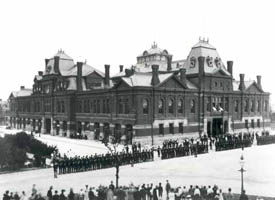 George Pullman revolutionized long-distance rail travel in the 1860s with the invention of the Pullman Sleeping Car, a comfortable boxcar far superior to most accommodations of the time. The industrialist was also known for creating a workers’ community surrounding his factories just south of Chicago. The town of Pullman, Illinois grew to become internationally recognized for the level of offerings to its worker inhabitants. Gas and water hookups in each home, a large amount of green space and parks and other amenities distinguished Pullman from other company towns.
George Pullman revolutionized long-distance rail travel in the 1860s with the invention of the Pullman Sleeping Car, a comfortable boxcar far superior to most accommodations of the time. The industrialist was also known for creating a workers’ community surrounding his factories just south of Chicago. The town of Pullman, Illinois grew to become internationally recognized for the level of offerings to its worker inhabitants. Gas and water hookups in each home, a large amount of green space and parks and other amenities distinguished Pullman from other company towns.
While the community was known on the outside to be clean and progressive, tension between workers and factory owners was often high. A dramatic decrease in worker pay and benefits led to a violent strike in 1894 that left several dead and hundreds of rail cars burned. The strike and corresponding lock out of union workers would lead to several prominent and influential moments in American union history, including the celebration of the first Labor Day in 1894 and the rise of the nation’s first African-American union, the Brotherhood of Sleeping Car Porters.
After operations at the factories ceased in 1957, the neighborhood fell on hard times. With the area threatened with demolition in 1960, a group of residents advocated for its preservation and were successful in designating the area an Illinois Historic District in 1969 and a National Historic Landmark District in 1970. In February, President Obama designated the area a national monument, recognizing Illinois' history in the railroad industry and as a unique part of the birth of the labor rights movement in the United States.
Learn more:
Visiting the Pullman neighborhood? Click here for information on factory tours and tours of the famous Hotel Florence
Read more on the history of the Town of Pullman from the Chicago Historical Society





